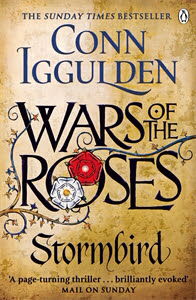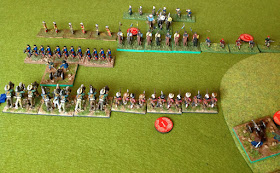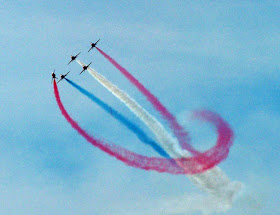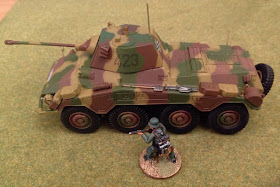Pages
Wednesday, 30 December 2015
Brothers' Fury - Giles Kristian
Monday, 28 December 2015
Somua S-35 in German service
Given the growing pile of metal (and plastic) on my painting table, my Christmas list was very restrained this year. However, one addition was some 28mm armoured support for my German WW2 units serving in the Balkans.
I thought I would start with a PKW III, however, the Warlord model is part of their link up with the kit maker Italeri. If you are a model kit builder this is fine, but they are not good wargame models. They are too fiddly and time consuming to build, and more importantly, simply not robust enough for the wargames table. The tracks in particular are not nearly strong enough, even if you manage to construct them.
My pre-Christmas trip down to my Mum's included a stop over in what is probably my idea of heaven - the book town of Hay on Wye. A castle, good pubs, and over 20 second hand bookshops. One of my many purchases was a MMP publication on the 'Prinz Eugen' Division. This superbly put together publication has masses of photographs of the division in action in the Balkans. What caught my eye was the extensive use of captured French armour. I was aware of the H38 and R35 being used, but not the much heavier Char B1. 17 of these heavy tanks went to the Balkans.
However, I settled on the Somua S-35, not least because the Warlord model is one of their much more robust resin models. Just a few parts that go together quickly, even the gun barrel has a half decent lug, one of my pet hates with poor tank model design.
German forces in the Balkans had 43 tanks of this type used by Panzer Battalion 202 and 212 as well as Special Purpose Armoured Company 12. They were known as Panzerkampfwagen Somua 35S(f) 739 in German service.
The S-35 was built between 1936 and 1940 for the French Cavalry Divisions. For its time it was a well designed tank, better than most of its opponents. The problem was a complex and expensive production methodology and poor strategic and tactical deployment. Around 440 were built. It had a 47mm main gun and MG, with a petrol engine that managed 25mph on roads and around 20mph cross country. I have seen originals at Saumur, Bovington and in the USA. A few in Bulgarian service survived in post-war police roles.
I painted this model Panzer Grey, added some German markings and dirtied it up with plenty of Balkan mud. A very decent model that does the job well.
Friday, 25 December 2015
Dragon Rampant
Having played Lion Rampant I decided to give the recently published fantasy version a go. Also an opportunity to dust down my box of fantasy figures.
The essence of the rules are the same, so I won't repeat my explantation of the game mechanics. The rules use the same basic unit structure and game mechanisms for movement, shooting and combat. Retinues become warbands.
In this version you get some additional units, including two sizes of war beasts for those big models. The big addition is a section called fantastical rules. Here you can add hate, terror etc and of course magic. You can pay for different types of spellcasters who can use a range of spells, the more powerful of which require higher dice throws to activate.
As with Lion Rampant, you get a number of scenarios and sample army lists. Although again you are encouraged to make up your own.
So, onto the tabletop. We have an Orc Warband with a Big Boss, an Orc Shaman with a few limited spells, and several units of warriors classed as Bellicose Foot. They all have Wild Charge, so that's what they do once in attack range.
Their opponents are Goblins led by a Daemon Prince, with a Shaman, wolf riders, archers and several units of spear armed warriors.
The Orcs rather predictably stormed across the table, scattering the Goblins whose shooting abilities caused some damage.
The Daemon Prince was left a bit isolated, but difficult to kill. The solution was to use a spell from the Orc Shaman that leaves units 'battered', fighting at reduced strength, and then attack with another unit. With the death of their leader that was game over for the Goblins.
As with Lion Rampant, the rules provide for a quick and enjoyable game. Unlike some fantasy rules the magic element isn't dominant, it provides a bit of longer range artillery and other benefits. You can use any figures in these rules you want and Warbands are limited only by your imagination.
I enjoyed these rules and will certainly use them again.
Tuesday, 22 December 2015
Lion Rampant
The holiday break is an opportunity to catch up on some outstanding projects, one of which is trying out the Lion Rampant rules. These are pretty popular at my club, even eclipsing SAGA at present.
Lion Rampant is published by Osprey and written by Daniel Mersey. They are a simple set of rules for the medieval period based around a retinue of typically around 50 models in six or so units of 6 or 12 figures, although you can do smaller and bigger actions. It's not quite skirmish, but it is part of trend towards smaller games that don't require a year's painting before you get a game on the table. A 6' by 4' table is standard.
Each retinue has a leader, who is important, but not a super hero. Try not to get him killed though, as the courage tests can be painful. The activation sequence starts with Leaders issuing challenges, rallying battered units and testing for wild charges by your Knights. However, the key is ordered activations that require different dice throws to move, shoot or attack. This is very clever as it reflects a units willingness do undertake different actions. For example, knights are difficult to get moving but easy to charge. If you fail an activation, your turn ends, a bit like Black Powder. This means you need to decide which activations are most important to your battle plan and have lower dice requirements, so the risk of failing is lower.
The shooting and combat mechanisms are very straightforward, based on the ability of the unit and the armour class to survive hits. You remove models and that weakens the unit's impact once you reach half strength. Losing figures is even more important in the courage (morale) tests that you have to take after losing casualties, because they get deducted from the dice roll.
The game is usually played to a number of scenarios, but you can make your own up. These are typically small action scenarios around raiding, convoys and collecting taxes.
There are a few sample army lists, but you are encouraged to write your own, with some limitations to stop super army design. There are eleven troop types, all typical Western European medieval types, but you can rename them for other parts of the world. These are adequate, but might need a bit of tweaking for units like Janissaries, who don't fit well.
So, onto the tabletop. My retinues, you will be surprised, are from the Balkans! Bosnians and Ottomans for this play test. The Ottomans are the attackers and made it across the table quickly (horses move 10/12" and foot 6/8"), while the Bosnians kept failing activations and largely hugged the baseline.
This helped the Ottomans who are strong in shooters and they peppered the Bosnians causing courage tests and consequential retreats.
The Bosnian Knights eventually got a wild charge in but were clevely lured onto rough ground that made them less effective. When they routed it was game over and mass conversions followed!
These are definitely my type of rules. Simple, easy to remember game mechanics, yet plenty of subtle game play. Recommended.
Tuesday, 15 December 2015
Strathclyde and the Anglo-Saxons in the Viking Age
One book I have finished is Tim Clarkson's 'Strathclyde and the Anglo-Saxons in the Viking Age'. This has been on the reading shelf for some time and I picked it up knowing very little of the kingdom that that covered the area where I live today. I suspect my solitary knowledge was the partial chapter in the WAB Age of Arthur book and the stones at Govan Old Parish Church in Glasgow.
Strathclyde is the modern name for Strat Clud, indicating a kingdom based on the strath or lower valley of the River Clyde. They were also known as Cumbrians and their kingdom stretched from Glasgow down the Solway Firth and then on into modern day Cumbria.They were ethnically Britons or North Welsh, but as becomes clear in the book, we know very little about them. The limited sources almost all come from mentions in the annals of other nations.
The book covers the period from the middle of the 8th Century to the beginning of the 12th. From the capture of their original capital on Dumbarton Rock by the Vikings, until they were overrun by the Scots and the Scottish parts of Strathclyde became part of Scotland.
It covers conflicts with the Vikings, the Anglo Saxons and less frequently the Kingdom of Alba. They were probably present at the great battle of Brunanburgh in 937 when the Saxons defeated the Norse and their Scots and Strathclyde allies - even if no one is quite sure where the battle site is.
The other great battle was Carham in 1016 or 1018, between the English and the Scots. The English or more properly the Northumbrians, were probably commanded by Earl Uhtred of Bamburgh. Yes, that's Bebbenberg. For those watching 'The Last Kingdom' or reading the Bernard Cornwell books, a Uhtred did actually exist. He was obviously a renowned warrior and leader, but perhaps not quite as well travelled as Cornwell's character!
This book fills a gap in our understanding of a Kingdom that was an important part of Dark Ages Britain. I will look that bit more carefully at the stones on my next visit to Govan.
Monday, 23 November 2015
Warriors of the Storm
This is the latest in the renamed 'The Last Kingdom' series to match the title of the new TV series. Our hero Uthred tackles a norse Jarl Ragnall Ivarson who attempts to conquer parts of England. Driven out of his previous territory in Ireland, this Jarl sails into the Mersey, which is held by Uhtred, and links up with Viking Northumbria. After beating off Ragnall, we have a diversion to Ireland where he rescues his Daughter, married to Ragnall's estranged brother Sigtryggr, and together their joint army lands in Cumbria. From there they capture York and make Sigtryggr King of Northumbria. The book ends as usual with a climatic battle at which Ragnall meets a well deserved end.
This book has just about everything. A solid plot, very loosely based on what little we know of the actual history, great characters, humour and of course action. Cornwall does battle scenes like no other author.
Nothing more to be said. Just read it!
Tuesday, 17 November 2015
Greece 1940-41
'The Defence and Fall of Greece 1940-41' by John Carr, primarily covers the Italian invasion of Greece that started in October 1940.
It plugs an important gap, in the English language at least, in the history of the Balkans in World War 2. Mario Cervi's excellent 'Hollow Legions' looks at the campaign from the Italian side, albeit critically. I used his work, together with the memoirs of British participants, in my own article on the campaign after I visited some of the battlefields and the museum at Kalpaki. This really is one battlefield you need to visit to understand what happened.
Mussolini's bungled campaign was far from the quick campaign he planned. Badly led Italian divisions ground to a halt against determined Greek resistance, in terrain that levelled the technical inferiority of the Greek forces. A Greek counterattack forced the Italians back into the Albanian mountains and a winter campaign that took a terrible toll on both armies. By the Spring, Hitler was forced to bale out his allies with a blitzkrieg in the Balkans that rolled up the exhausted Greek armed forces and their recently arrived British and Commonwealth allies.
The author has drawn heavily on Greek sources for this book, both from the diaries of front line soldiers as well as the war diaries of Prince Peter, who served on the General Staff and as liaison with the British. It covers the war on the ground as well as in the air and at sea. It is very well written, a real page turner. It could have done with more maps and illustrations, but that is a small criticism for what is an excellent history.
Reading the book inspired me to dust down my 15mm Flames of War armies for the campaign. On this occasion the Italians broke through.
Here is the battlefield with the Italians storming across a stream from the left.
Finally a link to my 25mm figures for the campaign. You can tell I'm really into this period!
Saturday, 24 October 2015
Shattering Empires - Russia and Turkey 1908-18
Tuesday, 13 October 2015
The Last Ironsides
My half term holiday reading has been Jonathon Riley's 'The Last Ironsides'. I am often attracted to obscure campaigns and I picked up this book in a London bookshop a while ago. It is a history of the English expedition to Portugal 1662-1668.
Portugal had been fighting for its independence from Spain for many years when Charles II was restored to the British throne. He agreed to marry the Infanta, Cathrine of Braganza, in return for a much needed cash dowry, trade concessions, and possession of Bombay and Tangier.
Part of the deal was that he would send two regiments of foot and a regiment of horse to support the Portuguese army. This was an opportunity to ship out of the country the remnants of Cromwell's New Model Army. A win-win deal by any standard.
The author covers the diplomatic background and then the campaigns the English regiments fought in. They became, with French regiments, the cutting edge of the Portugese army and distinguished themselves in several battles and sieges. Only a thousand were left standing when the war was won and 400 of these were sent to Tangier, a virtual death sentence in itself.
The English regiments mostly fought in Southern Portugal and Spain. Many of the place names are familiar to the later Peninsular War campaigns in the early 18th and 19th centuries. Badajoz, Merida and Albuquerque, amongst others.
The book is well illustrated with period drawings and modern maps. The English regiments even kept their New Model Army redcoats, so this provides another campaign for wargamers with later civil war armies.
Monday, 12 October 2015
Stormbird
The Wars of the Roses has never been a period of great interest to me. Perhaps being born in Lancashire, but married to a Yorkshire woman, has meant that this is a subject best avoided! In wargaming terms the serried ranks of archers and plate armed foot lumbering towards each other for a slog fest, has also never appealed.
However, it is certainly in fashion at present. Dan Jones's book looks interesting, but I was drawn in by Conn Iggulden's series of historical novels, staring with Stormbird.
He starts in 1437, when Henry VI, the Lamb, accedes to the English throne after years of regency. As the name suggests, he was not a chip of the old block of his father Henry V, hero of Agincourt. His poor health and frailty of mind render him a weakling king, relying on his closest men, Spymaster Derry Brewer and William de la Pole, Duke of Suffolk. Others, such as the Plantagenet Richard, Duke of York, believe England must be led by a strong king if she is to survive.
This book focuses on a secret deal struck for Henry to marry a young French noblewoman, Margaret of Anjou, in return for territories in France. However, one of the book's heroes, Thomas Woodchurch, an archer living in these territories, resists the French occupation. This allows the French King to capture most of the English territories in France. Woodchurch then returns to Kent and takes part in Cade's rebellion.
Iggulden is of course a first rate writer and this is classic historical fiction. Well researched, plenty of action, and numerous sub plots. I doubt if it will make the period any more attractive to me in wargaming terms, but it's a great read.
Sunday, 4 October 2015
Battle of Leva 1664 - the game
There is a very good article by Iain Stanford in the latest edition of The Arquebusier on the 4th Austro-Turkish War 1663/4 and the battles of Leva (Levice) and St Gotthard.
Leva was the smaller warm up to the more decisive clash at St Gotthard, but it is a very manageable game for the tabletop. I used 15mm figures and Pike and Shotte rules.
The Imperial forces in Northern Hungary were commanded by Souches and he was opposed by Ottoman forces, including Wallachian and Moldavian vassals, commanded by Ali Pasha of Buda. Souches was besieging Leva when he heard Ali Pasha had moved to cut off his lines of communication. So he abandoned the siege to meet the Ottoman army.
The Ottoman forces crossed the river towards the visible Left and Right wings of the Imperial army. The centre was held back behind some woods. Ottomans on the right of this photo.
The Imperial left commanded by Knigge advances against the Wallachians with Tartar horse.
While the Moldavians advance boldly against the Imperial right commanded by Heister.
The Wallachians get the upper hand.
But it's harder going for the Moldavians. Those curaissiers aren't much bothered by Tartar arrows and the best Moldavian cavalry is slow to advance because of shooting disorganisation.
Then the Imperial centre advances against the best Ottoman troops, the Janissaries.
However, they are split because the Wallachians rout the Imperial left wing.
Game over when the Moldavians do the same on the Imperial right.
A reversal of history as in the historical battle the centre crushed the Janissaries and then rolled up the Moldavians.
An enjoyable game, that the rules played well. My only reservation is how they treat pike and shot regiments, it doesn't feel quite right. FoGr does this better, but the command mechanisms in Pike and Shotte work better for this period. Ah, the search for the perfect rule set goes on!
Monday, 21 September 2015
Sheriffmuir 1715 - on the tabletop
The last unit of lowland militia finished. These are League of Augsburg figures. A more slender sculpt than Front Rank and others chosen for this project.
This enabled me to get the whole project on the table for a game using Donnybrook rules. These work well for this period, nice easy mechanics that allow a quick game. A bit too quick for the Jacobites, as the highlanders got gunned down by the regulars and militia firepower. The horse did better, riding down the militia at least.
Sunday, 13 September 2015
Sheriffmuir 1715 - The Horse
Here we have some fine mounted gentlemen to ride down the riff raf.
And then some command figures.
Just the lowland foot to finish off and we can have some tabletop action.
Saturday, 12 September 2015
A Man Most Driven
Peter Firstbrook has written a biography of Captain John Smith, famous for being saved from execution by a Native American tribe, by his captor's daughter, Pocahontas.
American history isn't normally my thing, but this biography attracted me because of John Smith's earlier exploits were in the Balkans. Between 1601 and 1604, Smith was a mercenary captain in the Habsburg armies fighting the Ottoman Turks.
It is a pretty astonishing story as well. Smith fought in Hungary, Translyvania and Wallachia, before being captured by the Turks. He then spent a short period as a slave, before escaping through Muscovy.
We have very few English language sources for these campaigns. Of course we have Smith's own account, but what the author has done is to check that account by travelling the same route. He has given us credible evidence on the places and battles Smith took part in. As best he can, he concludes that most of Smith's account is probably broadly correct.
This is also a very readable history. It's also a great story of very interesting character. You will find this a difficult book to put down.
Sunday, 6 September 2015
Scottish Air Show
The Saturday is the air display off the coast near Ayr and the Sunday is the static display day, plus take offs at Prestwick airport.
The star for me was the B17.
Monday, 31 August 2015
Sd.Kfz. 234/2 Puma
I was following a thread on a bulletin board about roughly 20mm Russian tanks and a Matilda available at some branches of The Works. Thinking, as did others, why are they never done in larger scales for Bolt Action
I was in Beverley, Yorkshire over the weekend at a wedding and decided to stretch my legs with a walk around the town. Passing The Works branch I popped in to see if they had them. They didn't, but they did have a few very nice Puma armoured cars. No indication of scale, but obviously bigger than 20mm. No manufacturer either, although they are made in China.
On getting them home and measuring up, they appear to be roughly 1/45 scale. A bit big for 28mm, but not absurdly so. They are marketed as 20 Panzer Division, Sudetenland 1945. They look pretty accurate models to me and will look good when weathered. At £10 each, I hope there are more in this range.
Three views of the model with a 28mm German infantryman, so you can make your own mind up.



















































